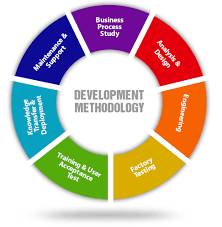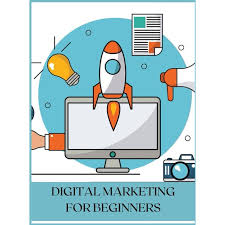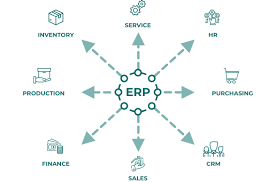Crystal Software Development: The Future of Efficient and Secure Applications
In the fast-paced world of software development, where efficiency and security are paramount, Crystal programming language has emerged as a promising solution. Crystal combines the best features of statically typed languages like C or C++ with the simplicity and expressiveness of Ruby. This unique blend makes it an ideal choice for developers seeking high-performance applications with enhanced security.
One of the key advantages of Crystal is its static typing feature. Unlike dynamically typed languages, Crystal performs type checking at compile-time, catching potential errors before they even occur. This not only improves code quality but also enhances performance by enabling better optimization during compilation. With its strong type inference capabilities, Crystal allows developers to write concise and readable code while maintaining a high level of safety.
Another notable aspect of Crystal is its ability to seamlessly interface with existing C libraries. This opens up a vast array of possibilities for developers, allowing them to leverage the extensive collection of established C libraries while enjoying the benefits of Crystal’s modern syntax and language features. By combining the power and efficiency of low-level languages with the elegance and expressiveness of high-level languages, Crystal offers a unique development experience.
Security is a critical concern in today’s digital landscape, and Crystal addresses this issue effectively. Its static typing system helps prevent common vulnerabilities such as null pointer dereferences or buffer overflows that often plague dynamically typed languages. Additionally, Crystal’s built-in memory management ensures automatic memory deallocation without requiring manual intervention from developers. These features contribute to more robust and secure applications that can withstand potential security threats.
Crystal also boasts excellent concurrency support through its lightweight fibers mechanism. Developers can write asynchronous code that runs concurrently without the complexity typically associated with multi-threading or event-driven architectures. This enables efficient utilization of system resources while maintaining code readability and ease of maintenance.
Furthermore, Crystal has an active community that continuously contributes to its growth and improvement. The community-driven nature ensures regular updates, bug fixes, and the development of new libraries and tools. With a growing ecosystem, developers can rely on a wide range of resources to enhance their productivity and accelerate their software development process.
In conclusion, Crystal software development offers a compelling solution for developers seeking efficient and secure applications. Its combination of static typing, seamless C integration, enhanced security features, lightweight concurrency support, and active community make it an attractive choice for modern software projects. As the demand for high-performance and secure applications continues to rise, Crystal is poised to play a significant role in shaping the future of software development.
A Comprehensive Guide to Frequently Asked Questions about Crystal Software Development
- What is the difference between Crystal Red and Crystal Orange?
- What is the difference between scrum and crystal?
- What is crystal clear in Agile methodology?
- What is crystal software development?
- Why Crystal is called a family of agile methods?
- What is crystal approach in agile?
What is the difference between Crystal Red and Crystal Orange?
Crystal Red and Crystal Orange are two distinct varieties of crystals, each with its own unique characteristics and properties. Let’s explore the differences between these two types:
- Color: As the names suggest, the primary difference lies in their color. Crystal Red typically has a deep red or reddish-brown hue, while Crystal Orange exhibits a vibrant orange coloration. The variation in color is due to different mineral compositions and impurities present within the crystals.
- Composition: Crystal Red is often associated with minerals such as hematite or garnet, which contribute to its red tones. On the other hand, Crystal Orange may contain minerals like calcite or carnelian that give it its distinctive orange color.
- Energy and Meaning: Crystals are often believed to possess energetic properties and are used for various metaphysical purposes. Crystal Red is associated with grounding energy, strength, courage, and vitality. It is believed to promote stability and protection while stimulating passion and creativity. Crystal Orange, on the other hand, is associated with joy, enthusiasm, motivation, and optimism. It is thought to bring warmth, confidence, and a sense of abundance.
- Chakra Association: In some belief systems related to chakras (energy centers in the body), different colors are associated with specific chakras. Crystal Red is commonly linked to the Root Chakra (located at the base of the spine), which governs feelings of safety, security, and stability. Crystal Orange is often connected to the Sacral Chakra (located in the lower abdomen), which influences emotions, creativity, sensuality, and personal power.
- Aesthetic Appeal: The visual appeal of crystals can vary widely based on personal preferences. Some individuals may be drawn more towards the deep red hues of Crystal Red due to their association with strength and grounding energy. Others may find the vibrant orange tones of Crystal Orange more appealing for their connection to joyfulness and enthusiasm.
It’s important to note that these differences are general observations and may not apply to every individual crystal specimen. Crystals can vary in their specific mineral composition, intensity of color, and energetic properties. When working with crystals for metaphysical purposes, it is advisable to choose the one that resonates with you personally, regardless of its color or name.
What is the difference between scrum and crystal?
Scrum and Crystal are both popular methodologies used in software development, but they have some fundamental differences in their approaches. Here are the key distinctions between Scrum and Crystal:
- Focus on Flexibility: Crystal methodology emphasizes flexibility and adaptability to meet project requirements. It encourages tailoring the process to fit the specific needs of the team and project, allowing for more freedom in decision-making. On the other hand, Scrum follows a more structured framework with predefined roles, events, and artifacts that must be followed.
- Team Size: Scrum is typically suited for larger teams with defined roles such as Product Owner, Scrum Master, and Development Team. It provides clear guidelines on team composition and responsibilities. In contrast, Crystal methodology is more flexible when it comes to team size and structure. It encourages small teams that can communicate efficiently without rigid role assignments.
- Documentation: Scrum places emphasis on documentation through artifacts like product backlogs, sprint backlogs, and user stories to ensure transparency and alignment within the team. Crystal methodology promotes lightweight documentation, focusing more on effective communication through face-to-face interactions rather than extensive written documentation.
- Planning Approach: Scrum follows a time-boxed approach where work is divided into fixed-length iterations called sprints. The scope of work for each sprint is determined during sprint planning sessions. In Crystal methodology, planning is based on prioritizing features or requirements using techniques like “Frequent Delivery” or “Feature Teams.” This allows for continuous adjustment of plans based on evolving needs.
- Emphasis on Roles: Scrum has clearly defined roles like Product Owner, Scrum Master, and Development Team members with specific responsibilities assigned to each role. In contrast, Crystal methodology places less emphasis on predefined roles and encourages collaboration among team members without strict role divisions.
- Risk Management: While both methodologies acknowledge the importance of risk management, they approach it differently. Scrum addresses risks through regular sprint reviews, retrospectives, and adaptation during the project. Crystal methodology, on the other hand, focuses on reducing risks through incremental delivery, frequent feedback loops, and continuous improvement.
It’s important to note that both Scrum and Crystal aim to improve the software development process and deliver high-quality products. The choice between these methodologies depends on factors such as project size, team structure, flexibility requirements, and the level of documentation desired. Ultimately, it’s essential to assess the specific needs of your project and team before deciding which methodology is best suited for your circumstances.
What is crystal clear in Agile methodology?
In the context of Agile methodology, “crystal clear” refers to one of the principles outlined in Alistair Cockburn’s Crystal family of methodologies. Crystal Clear is a lightweight and flexible approach to software development that emphasizes communication, simplicity, and personal interactions within a team.
The term “crystal clear” represents the idea that the project’s objectives, requirements, and goals should be clearly understood by everyone involved. It emphasizes the importance of open and transparent communication within the team to ensure a shared understanding of project expectations.
In Crystal Clear, teams are encouraged to have frequent face-to-face interactions and discussions with stakeholders. This helps clarify any ambiguities or misunderstandings early on, allowing for quick adjustments and adaptations as needed. By maintaining clear lines of communication, teams can avoid misinterpretations or assumptions that may lead to project delays or errors.
Furthermore, Crystal Clear promotes simplicity in both processes and documentation. Instead of burdening the team with excessive paperwork or complex procedures, it encourages lightweight documentation that is just enough to support effective collaboration and understanding. This approach allows teams to focus on delivering value quickly rather than getting caught up in bureaucratic overhead.
Crystal Clear also recognizes the importance of individual skills and talents within a team. It encourages self-organization and trusts individuals to make decisions based on their expertise. By empowering team members and promoting their autonomy, Crystal Clear fosters an environment where individuals can take ownership of their work and contribute effectively to the project’s success.
Overall, “crystal clear” in Agile methodology signifies a commitment to open communication, simplicity, shared understanding, and trust within a team. It emphasizes the importance of clarity in project goals and requirements while promoting flexibility and adaptability throughout the software development process.
What is crystal software development?
Crystal software development refers to the process of creating applications using the Crystal programming language. Crystal is a statically typed, compiled programming language that combines the syntax and expressiveness of Ruby with the performance and efficiency of languages like C or C++. It aims to provide developers with a productive and efficient environment for building high-performance applications while maintaining a strong focus on safety and security.
Crystal is designed to be easy to read and write, allowing developers to write concise and expressive code. It supports static typing, which means that type checking is performed at compile-time, catching potential errors before the code is even executed. This helps improve code quality and reduces the likelihood of runtime errors.
One of Crystal’s notable features is its ability to seamlessly interface with existing C libraries. This allows developers to leverage the extensive collection of established C libraries while enjoying the benefits of Crystal’s modern syntax and language features. By combining low-level efficiency with high-level expressiveness, Crystal offers a unique development experience.
Crystal also prioritizes security by providing features that help prevent common vulnerabilities such as null pointer dereferences or buffer overflows. Its built-in memory management system ensures automatic memory deallocation without requiring manual intervention from developers, reducing the risk of memory-related vulnerabilities.
Furthermore, Crystal offers lightweight concurrency support through its fibers mechanism. Developers can write asynchronous code that runs concurrently without dealing with the complexities typically associated with multi-threading or event-driven architectures. This enables efficient utilization of system resources while maintaining code readability and ease of maintenance.
Crystal has an active community that contributes to its growth and improvement by developing libraries, tools, and sharing knowledge through forums and documentation. This vibrant ecosystem provides developers with valuable resources to enhance their productivity and accelerate their software development process.
Overall, Crystal software development provides developers with a powerful yet accessible programming language for creating efficient, secure, and high-performance applications across various domains.
Why Crystal is called a family of agile methods?
Crystal is often referred to as a “family of agile methods” because it encompasses a collection of methodologies that share common principles and values. The term “family” is used to emphasize the flexibility and adaptability of Crystal, as different methodologies within the family can be tailored to suit specific project requirements.
The Crystal family of methodologies was introduced by Alistair Cockburn, one of the pioneers of the Agile Manifesto. It was developed as an alternative to traditional heavyweight software development processes that often proved inflexible and cumbersome for certain types of projects.
Crystal methodologies prioritize people and interactions over rigid processes and tools. They promote close collaboration between team members, recognizing that effective communication and teamwork are crucial for project success. Crystal methodologies also emphasize the importance of delivering working software incrementally, focusing on delivering value early and frequently.
One key aspect of Crystal is its emphasis on tailoring the methodology to fit the unique characteristics of each project. Different projects have varying levels of complexity, team sizes, risks, and priorities. Crystal provides a range of methodologies with different levels of formality and ceremony, allowing teams to choose an approach that best suits their specific needs.
For example, Crystal Clear is a lightweight methodology within the Crystal family that is well-suited for small teams working on relatively straightforward projects with low risk. On the other hand, Crystal Orange is designed for larger projects with more complex requirements and higher risks.
The “family” concept also highlights the shared values and principles across all Crystal methodologies. These include active user involvement, frequent delivery iterations, reflective improvement through retrospectives, osmotic communication (informal information exchange), and personal safety (creating an environment where team members feel safe to take risks and learn).
By being part of a family rather than a single rigid methodology, Crystal recognizes that there is no one-size-fits-all approach to software development. It acknowledges that each project has its unique characteristics and requirements that need to be considered when selecting and tailoring the methodology. This flexibility and adaptability make Crystal a family of agile methods, providing teams with options to choose the most suitable approach for their specific project context.
What is crystal approach in agile?
Crystal is an agile software development methodology that emphasizes flexibility and tailoring the process to fit the specific needs of a project. It was introduced by Alistair Cockburn, a renowned software development expert, in the late 1990s.
The Crystal approach recognizes that not all projects are the same and that different projects require different levels of formality and processes. It acknowledges that one size does not fit all when it comes to software development methodologies. Instead, Crystal focuses on adapting the methodology to match the unique characteristics of each project.
In Crystal, there are several variants or “colors” that represent different levels of formality and processes. These colors range from Crystal Clear (the lightest-weight variant) to Crystal Orange, Yellow, Green, Blue, and even more formal variants like Crystal Maroon or Diamond. Each color represents a set of practices and guidelines tailored for specific project characteristics such as team size, criticality, priorities, risks, and available resources.
The key principles of the Crystal approach include:
- People-oriented: Recognizing that people are at the heart of successful software development projects. The focus is on effective communication, collaboration, and empowering team members to make decisions.
- Incremental delivery: Emphasizing iterative development with frequent releases to gather feedback early and continuously refine the product.
- Reflective improvement: Encouraging teams to regularly reflect on their process and make adjustments based on lessons learned throughout the project.
- Close involvement with stakeholders: Ensuring active participation from stakeholders throughout the development process to maintain alignment with their needs and expectations.
- Skill matching: Assigning team members based on their skills and strengths to maximize productivity and efficiency.
- Osmotic communication: Promoting an environment where information flows freely within the team through osmosis rather than relying solely on formal communication channels.
- Automated testing: Advocating for automated testing practices to ensure high-quality code and reduce the risk of defects.
The Crystal approach recognizes that different projects have different levels of complexity, team sizes, and criticality. By tailoring the methodology to fit these unique project characteristics, Crystal aims to increase the chances of project success while maintaining a focus on agility and adaptability.




